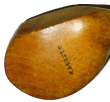
|
Registration Edit profile catalogue auction shopping cart shipping history makers search faq news links about contact |

Clubmakers
Andrew Bowie Sunter
Elie and Earlsferry
A belated entry in the war dead for Andrew Sunter after several years to- and fro-ing on whether or not he was a golf professional. When I first produced the name, the late Phil Weaver, curator of PGA heritage, was quick to add it to his list of golf professionals killed in the First World War on the basis that the PGA constitution allowed for the election of clubmakers as members. I was reluctant to accept the criterion of being a clubmaker as a criterion for inclusion just because it allowed for the possibility of election. My initial justification for including someone in the list as a golf professional was that a viewer of the site might come across a club marked with the relevant name: this would include club professionals and clubmakers operating on their own account. That is the only reason assistants are listed by name only without a biography. As clubmaking became increasingly more mechanised there would be ‘clubmakers’ who never swung a club in anger and had only a part in the process of manufacture such as polishing heads. Their sacrifice in the war was, of course, no less but (a) this is not the place to commemorate them and (b) the list would increase in size enormously with very few sources from which to add detail to an entry.
I expanded the criteria somewhat by including anyone who had carried out one or more of the functions of the modern professional and was paid for it or stood to win money, running a club while selling and repairing equipment, giving lessons or playing in competitions as a professional. Clubmakers attached to a particular club would be treated as assistants. This still excludes greenkeepers where they were not also the club professional (the terms were often used interchangeably), caddies and clubmakers in ‘factories’.
So Sunter was a clubmaker for two prominent firms, played in club competitions with Earlsferry Thistle but only now that I have found a record of him playing in a competition as a professional have I included him here.
Andrew Alexander Sunter was born in Liberty Place, Elie, on 21 March 1884 to Christopher Sunter, a master stonemason, and his wife Robina, née Thomson. On the 1901 census he is a chemist’s assistant in Elie.
Sometime after this he began a clubmaking apprenticeship with A H Scott in the village. Now this was enough to make him a professional in the eyes of the R&A Rules Committee, a body regularly pilloried and mocked by its nearest publications, the Dundee Courier and The St Andrews Citizen for its decisions in this area, and he did play in the Elie Professional Tournament of 1902. He played in the monthly medals of the Earlsferry Thistle club between 1904 and 1906 but there was no restriction against professionals, they were simply suitably handicapped. He played in the 1905 Open Championship at St Andrews drawn with fellow villager, and the ultimate winner that year, James Braid in the first round. A 95 ensured that was the only round he would play.
In 1907 he moved to Montrose as a clubmaker with J & W Craigie and played for Montrose Mercantile in inter-club matches, a formidable team including Fred Findlay, Harry Hampton, Eddie Towns and Charlie Adams.
He also got married in 1907, to Isabella Wilson and this record is the first official document where he uses the name Andrew Bowie Sunter (although his golf competition entries had been under “A B Sunter”). Andrew Bowie Sunter was, in fact, his cousin, a couple of years older, the son of his uncle Alex in Edinburgh, and there is no immediately apparent reason why he switched names but Scots Law is fairly relaxed on this provided it is not done for fraudulent reasons.
His son, Christopher, was born six months later on 7 November 1907. In 1909 Andrew travelled to the United States, without wife or child, arriving in Boston from Liverpool aboard the Saxonia with his profession given as ‘golf professional’. The following year he appears on the New York census, staying with his brother in the Bronx and described as a general labourer doing odd jobs.
The next record of him seems to be in Canada when he volunteers for the Canadian Expeditionary Force. On his attestation in Winnipeg in June 1915 he gives his occupation as Farmer.
Serving with the 8th Battalion, Canadian Infantry (Manitoba Regiment), he was killed on 24 June 1916 and is buried in the Railway Dugouts Burial Ground (Transport Farm), Flanders, Belgium. Prior to his death he had been recommended for the DCM.
![]() Search the catalogue for
clubs by this maker
Search the catalogue for
clubs by this maker
site design dmc ltd | © 2000-2024 Antique Golf Clubs from Scotland